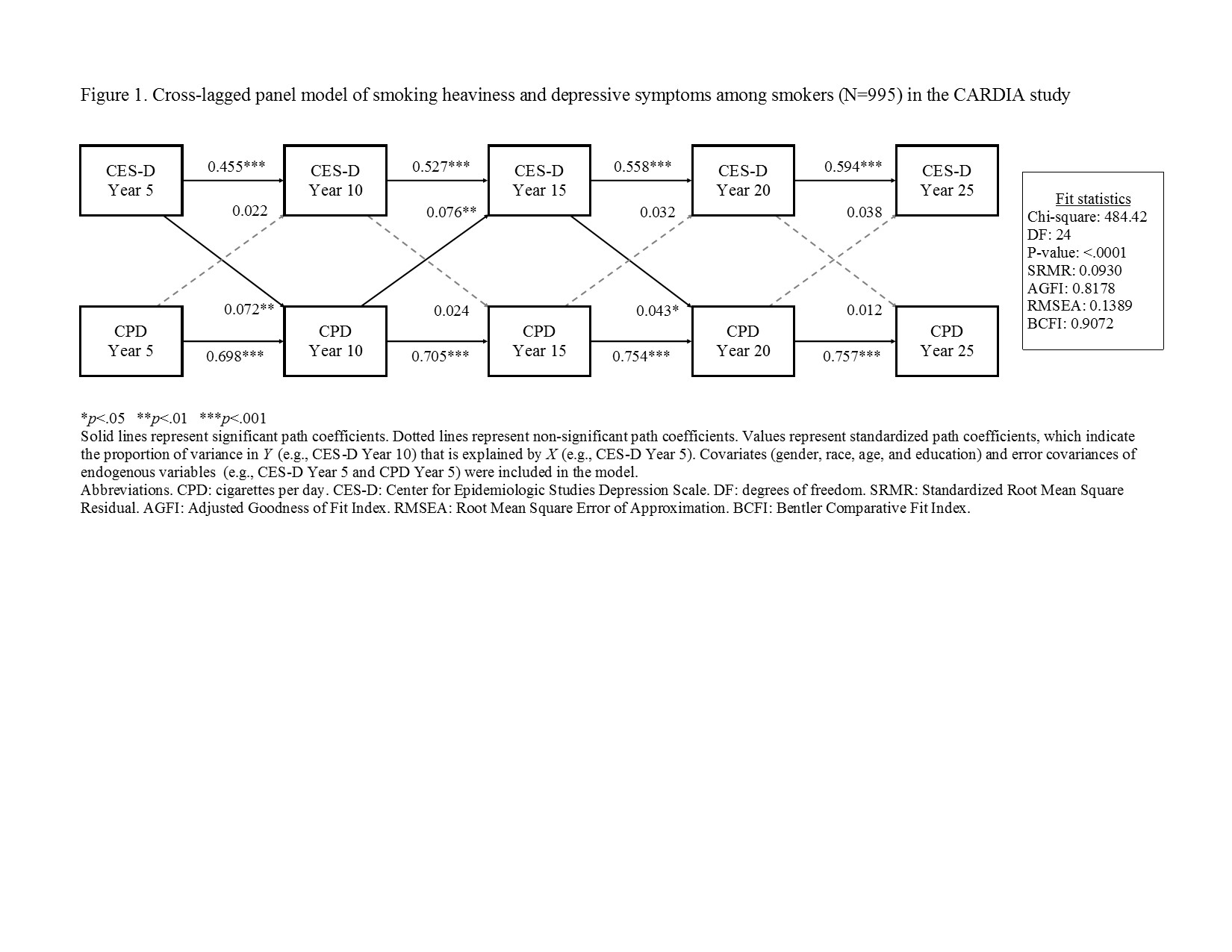Presenting Author:
Allison Carroll, M.S.
Principal Investigator:
Brian Hitsman, Ph.D.
Department:
Preventive Medicine
Keywords:
smoking, depression, panel analysis, epidemiology, cohort study
Location:
Third Floor, Feinberg Pavilion, Northwestern Memorial Hospital
PH44 - Public Health & Social Sciences
SMOKING AND DEPRESSION: EVIDENCE FOR BIDIRECTIONAL CAUSALITY? THE CARDIA STUDY
Background: Smoking and depression are highly comorbid. Evidence indicates that depression perpetuates smoking, and growing evidence suggests that smoking perpetuates depression. Cross-lagged panel modeling can isolate the potential bidirectional associations of smoking and depressive symptoms over time by simultaneously accounting for previous assessments, current associations, and variable error covariances. We evaluated bidirectional associations between smoking intensity and depressive symptom severity among smokers over 20 years. Methods: We used data from the Years 5, 10, 15, 20, and 25 exams of the Coronary Artery Risk Development in Young Adults (CARDIA) study. We included participants who attended all exams and reported ever smoking (packyears >0). Smoking was assessed as number of cigarettes per day (CPD). Depressive symptoms were assessed by the Center for Epidemiologic Studies Depression (CES-D) scale (score range: 0-60). We evaluated a cross-lagged panel model using PROC CALIS in SAS. We assessed autocorrelations (e.g. Year 5 CPD to Year 10 CPD) and cross-lagged associations (e.g. Year 5 CPD to Year 10 CES-D). Error covariances (e.g., Year 5 CES-D and Year 5 CPD) were included in the model. Results: Participants (N=995) were 58% female, 41% African-American, and 23-35 years old in Year 5 and 43-55 years old in Year 25. Whereas 56% were current smokers in Year 5, only 34% were current smokers in Year 25. The goodness-of-fit statistics indicated that the model was an adequate fit of the data (SRMR=0.093, AGFI=0.818, RMSEA=0.139, BCFI=0.907). All autocorrelations within CPD and CES-D scores were significant and increased over time (CPD path coefficients: 0.53 to 0.62); CES-D path coefficients: 0.46 to 0.59; all ps<.001). Significant but small cross-lagged associations were observed for Year 5 CES-D to Year 10 CPD (path coefficient=0.07, p<.01), Year 10 CPD to Year 15 CES-D (path coefficient=0.08, p<.01), and Year 15 CES-D to Year 20 CPD (path coefficient=0.04, p<.05); no other cross-lagged path coefficients were significant. Conclusion: Using an innovative application of cross-lagged panel analysis, we found small bidirectional associations between smoking intensity and depressive symptom severity that diminished over time, perhaps due to lower smoking rates. The relationship between intensity of continued smoking and depressive symptomatology may be better explained by other common factors (e.g., the “hardening” hypothesis), particularly later in adulthood.

